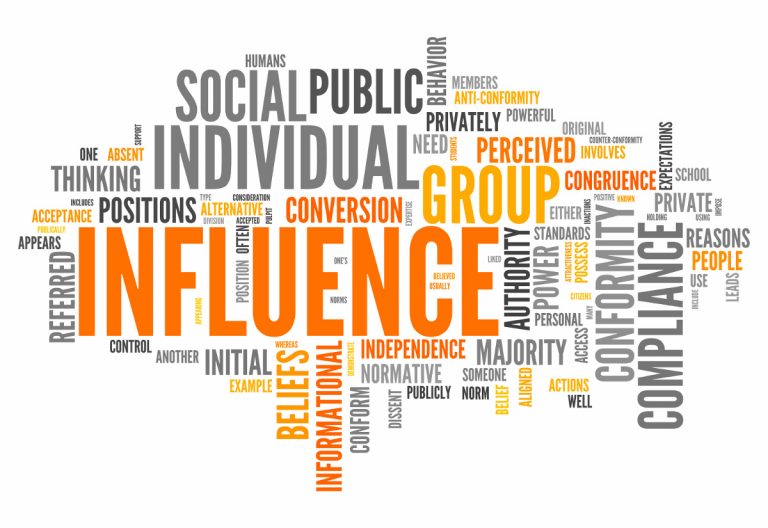Social and emotional intelligence is about influence. Leaders that inspire and motivate others do so by influencing their actions and behaviors. They bring people together through relationship building, understanding others, and developing trust. They understand how to influence without authority.
In the final week of our social and emotional intelligence series, we explore the area of cultivating influence, the fourth competency of the Bandelli Social and Emotional Intelligence Competency Model™. We define cultivating influence as a leader’s ability to communicate a well devised vision of the future, build trust among colleagues, and take effective action to accomplish organizational objectives. It is about inspiring people to perform above and beyond stated expectations.
Researchers in the field of industrial-organizational (I-O) psychology, define influence as the use of non-coercive tactics to direct and coordinate the activities of members of an organization toward the accomplishment of specific group objectives. In the management psychology literature, cultivating influence is embodied in the study of leadership.
Over the last twenty years, several leadership theories have become prominent in the I-O literature. These theories include: path-goal theory, leader-member exchange (LMX), transactional and transformational leadership, and charismatic leadership. Cultivating influence draws from the theory, research, and empirical results from each of these areas. For example, LMX (vertical dyad linkage) theory proposes that an interpersonal exchange takes place between leaders and their followers. The quality of this exchange is based on the leader and the follower’s technical skills, interpersonal style, trustworthiness, and levels of sensitivity. Additionally, researchers have expanded the relationship between leaders and direct reports to include: support, rewards, and job satisfaction. Each of the components of LMX theory are intimately linked to our four social and emotional intelligence competencies in our model. In particular, cultivating influence revolves around the development of a strong relationship between a leader and his/her followers. However, LMX theory differs from cultivating influence in that the vertical dyad relationships do not exist for all employees. More specifically, leaders tend to gravitate towards certain followers, causing an in-group versus out-group mentality. In contrast, our model views cultivating influence as a skill that can be applied to all leader—member relationships.
Research in I-O strongly supports the development and use of leadership in organizational settings. For example, several researchers examined the relationship between the Five-Factor Model of personality with both charismatic and transactional leadership on leaders perceived effectiveness in dynamic work contexts. Their results indicated that personality and leadership styles vary depending on the context. More specifically, they found that agreeableness and conscientiousness were positively related to perceptions of charismatic and transactional leadership. Additionally, their results indicated no direct relationship between perceived effectiveness and leadership style. However, they found an interaction effect indicating that direct reports’ evaluations of charismatic leader behavior were positively related to perceived effectiveness as rated by superiors and peers, but only under dynamic work conditions.
Many management consultants have also examined the positive benefits that come with effective leadership and influence styles. Some of these organizational outcomes include: organizational commitment, job satisfaction, employee well-being, cooperation, organizational identification, networking, job performance and productivity, and citizenship behaviors. Thus, it is apparent that the development and use of influence is critical to the success of various organizational outcomes.
There are several similarities between the cultivating influence competency and political skill. First, the political skill construct contains a dimension called interpersonal influence, which involves having a subtle and convincing personal style that exerts a powerful influence on others. Although this does not directly relate to effectively leading the actions and behaviors of others, it does speak to the flexibility and adaptation required in social situations to evoke desired responses from others. Thus, interpersonal influence and cultivating influence are related in that both dimensions use non-coercive behaviors when working with others in order to achieve one’s objectives.
Cultivating influence is also related to EI in that identifying, using, and effectively managing one’s emotions are critical to the success of any influence initiative. For example, several researchers suggested that those high in EI tend to be more secure in their personal abilities and can then provide individual focus to others as well as intellectually stimulate and motivate followers. Additionally, one researcher noted that EI is important for influencing the behaviors of others because it affects the level of empathy, their ability to manage the emotions of the group, and the perceptions they give off to their followers (e.g., ability to delay gratification when working long hours, overcoming temporary setbacks and minor frustrations). Thus, through the use of EI and its related abilities, individuals in leadership positions are more likely to cultivate charisma and exert powerful influence on other members of the organization.
Leadership is about influence. People with strong social and emotional intelligence understand how to cultivate influence and effectively guide the work and efforts of others. Like the three other competencies (e.g., establishing rapport, understanding others, and developing trust) of the Bandelli Social and Emotional Intelligence Competency Model™, cultivating influence is a learned behavior. Through coaching, feedback, and practice, leaders can develop the requisite skills needed to influence others.
This concludes our four-part series on social and emotional intelligence. Take the FREE ASSESSMENT about social and emotional intelligence.
For more information on the Bandelli Social and Emotional Intelligence Competency Model™ contact us at abandelli@bandelliandassociates.com
Leadership Matters. Without It, People Fail.


